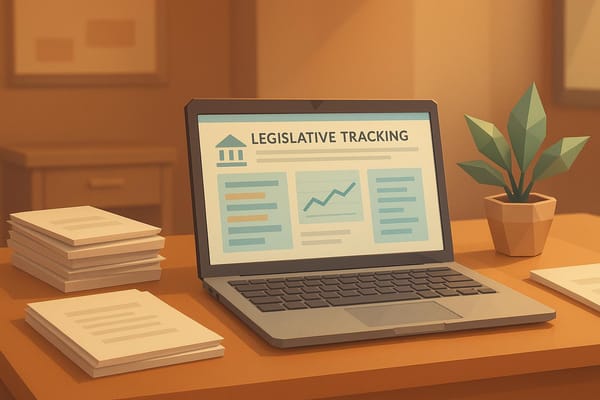How to Analyze a Bill Step by Step
Learn how to effectively analyze a bill step by step, from gathering key information to understanding its impact and using digital tools.

Want to understand a bill but don’t know where to start? Here’s a simple guide to break it down:
- Gather Key Information: Find the bill number, title, sponsors, status, introduction date, and committee assignments.
- Read the Bill’s Parts: Focus on the preamble, definitions, main provisions, and funding details.
- Check Effects: Identify who the bill impacts, analyze costs, and see how it fits with existing laws.
- Use Digital Tools: Platforms like cicada.guide offer AI summaries, Q&A features, and progress tracking to make analysis easier.
How to Read a Bill (and a Resolution)
Step 1: Gather Key Bill Information
Start by collecting all the basic details about the bill. This step ensures you're working with accurate and current information, giving you a clear understanding of the bill's context.
Locate the Bill Details
Every bill comes with specific information that helps track its journey through the legislative process. Here's what to look for:
- Bill Number: A unique code, like H.R. 1234 for House bills or S. 567 for Senate bills.
- Title: Includes both the short title (used in discussions) and the full legal title.
- Sponsors: The legislator(s) who introduced the bill.
- Current Status: The bill's current stage in the legislative process.
- Introduction Date: The date the bill was first presented.
- Committee Assignments: The committees responsible for reviewing the bill.
With tools like cicada.guide, you can easily find this information using the "For You" and "Discover" feeds. The platform organizes these details in a user-friendly format, making it simple to get started. Once you have this information, move on to reviewing the full text for a deeper dive.
Access the Full Bill Text
After identifying the bill, it's time to review its complete text. Focus on the latest version, any amendments, and additional documents like committee reports, fiscal impact statements, and legislative analyses. These resources will help you understand how the bill has changed over time.
Cicada.guide makes this process easier. Use the "Tracking" feed to stay updated on amendments or other changes, and take advantage of AI-powered summaries to quickly grasp the key points of complex legislation.
Step 2: Read the Bill's Parts
Start by breaking the bill down into its main sections.
Main Bill Sections
Bills are generally divided into key parts like the preamble, definitions, main provisions, and funding details.
Preamble and Title
Look for phrases such as "An Act to..." that explain the bill's purpose.
Definitions
This section explains specific terms used in the bill, which might have meanings different from their everyday use.
Main Provisions
This is the core section where you'll find details on:
- Actions that must or must not be taken
- Compliance rules
- Dates when provisions take effect
- How the bill will be enforced
Funding and Implementation
Review this section for information about budgets, timelines, reporting requirements, and the roles of different agencies.
Once you've reviewed these sections, focus on understanding the legal language with the help of a guide.
Legal Terms Guide
Understanding key legal terms is crucial for analyzing legislation effectively.
"Using AI and community feedback to distill complex legislation into clear summaries that cut through legal jargon." - cicada.guide
Tools like those offered by cicada.guide can simplify technical terms and make legal concepts easier to grasp. For example, the way terms are defined can significantly affect how a bill is applied.
Here are some common legal terms to know:
| Legal Term | Meaning | Importance |
|---|---|---|
| Shall | Mandatory action required | Indicates a legal obligation |
| May | Permitted but optional | Shows discretionary actions |
| Notwithstanding | Despite other laws | Overrides conflicting provisions |
| Subject to | Conditional upon | Depends on other rules or conditions |
Step 3: Check the Bill's Effects
Who It Affects
Start by identifying the main groups impacted by the bill:
- Direct Beneficiaries: Individuals or groups who receive new rights, protections, or benefits.
- Regulated Parties: Entities required to meet new rules or standards.
- Implementing Agencies: Government bodies tasked with enforcement and oversight.
- Indirect Stakeholders: Those affected indirectly through broader ripple effects.
The cicada.guide platform highlights which groups are affected. Once identified, the next step is to evaluate the financial impact of these changes.
Cost Analysis
Understanding the costs associated with the bill is crucial. Here's a breakdown of key cost elements:
| Cost Element | What to Look For | Why It Matters |
|---|---|---|
| Immediate Costs | Budget allocations, program funding | Direct impact on fiscal budgets |
| Implementation Costs | Expenses for agencies | Resources required for enforcement |
| Compliance Costs | Costs for businesses to comply | Economic burden on businesses |
| Revenue Changes | Tax or fee adjustments | Impact on government income |
Check the fiscal note for official cost estimates. Focus on areas like:
- Projections for costs over multiple years
- Expected revenue changes
- Costs tied to implementation timelines
- Differences in state and local government impacts
Related Laws and Rules
Beyond finances, examine how the bill fits into the broader legal landscape.
Constitutional Alignment
The cicada.guide tool flags any sections of the bill that might conflict with constitutional principles.
Existing Statutes
Evaluate how the bill interacts with current laws. Specifically, check if it:
- Modifies existing regulations
- Introduces new legal requirements
- Repeals outdated provisions
- Resolves conflicts with current legislation
Using tools from cicada.guide, you can also track related legislation to ensure no critical legal connections are overlooked. This helps clarify how the bill might influence or be influenced by other laws, ensuring a smoother implementation process.
Step 4: Use Digital Analysis Tools
Digital tools can simplify and enhance the process of analyzing legislation, saving time and providing deeper insights.
Features of Cicada.guide

Cicada.guide offers several tools to make bill analysis more efficient and user-friendly:
AI-Powered Bill Summaries
This feature breaks down complex legislative language into clear, concise summaries, helping users quickly grasp the main ideas.
Interactive Q&A System
With this tool, you can:
- Ask specific questions about bill provisions.
- Look up definitions of legal terms.
- Check dates for implementation.
- Review potential impacts of the legislation.
Progress Tracking Dashboard
Stay on top of a bill's journey with a personalized dashboard that tracks its progress through various stages:
| Stage | What to Track | Benefits |
|---|---|---|
| Introduction | Filing date | Understand the timeline |
| Committee | Hearing schedules | Prepare for hearings |
| Amendments | Changes to the original text | Stay updated on revisions |
| Floor Action | Voting schedules | Track key milestones |
Representative Analysis Tools
These tools provide insight into how lawmakers interact with legislation, including:
- Voting records on related bills.
- Alignment with constituent interests.
- Options to contact representatives directly for advocacy.
Additionally, standardized templates can help ensure a thorough and consistent approach to bill evaluation.
Developing Analysis Templates
Using standardized templates can help streamline and organize your evaluation process. Here's how to create and use them effectively:
Basic Template Structure
A well-structured template should include the following sections:
-
Bill Identification
- Official number and title
- Primary sponsors
- Current status
-
Impact Assessment
- Groups affected by the legislation
- Timeline for implementation
- Financial considerations
-
Legal Framework
- Connections to existing laws
- Constitutional factors
- Regulatory requirements
Integrating Tools Into Your Workflow
Combine templates with digital tools for a seamless analysis process:
1. Initial Review
Quickly assess new bills using AI-powered summaries. Set alerts for updates, such as amendments or status changes.
2. Detailed Analysis
Dive deeper into specific provisions using the Q&A feature. Record your findings in the standardized template for consistency.
3. Impact Tracking
Use platform analytics to monitor how the bill progresses and evaluate its effects once implemented.
Conclusion
Understanding and analyzing bills effectively requires a clear, methodical approach paired with the right digital tools. By breaking the process into manageable steps - gathering basic details, examining bill components, and evaluating potential outcomes - citizens can gain deeper insights into legislation that impacts their lives.
Digital platforms like cicada.guide make this process easier by turning dense legal jargon into straightforward summaries.
"cicada.guide was designed to empower citizens with accessible, actionable information about laws and legislative processes...ensures that every citizen, regardless of their political knowledge or tech-savviness, can participate in democracy effectively." - cicada.guide
To get the most out of your bill analysis efforts:
- Use tools like AI-driven summaries, interactive Q&A features, and progress dashboards on cicada.guide for a more efficient analysis process.
- Track your representatives' voting records to see how closely they align with your values.
- Communicate directly with lawmakers to voice your opinions and advocate for change.
FAQs
How can I use digital tools like cicada.guide to better understand and analyze legislative bills?
Digital tools like cicada.guide make analyzing legislative bills much easier by offering AI-generated summaries that simplify complex legal language and highlight key provisions. This helps you quickly grasp the main points and potential impacts of a bill.
Additionally, cicada.guide allows you to track bills through their legislative process, stay updated with real-time feeds, and even contact your representatives directly. You can also review your representatives' voting records to see how closely they align with your values, promoting greater transparency and accountability in the legislative process.
What are some common legal terms in bills, and why is it important to understand them?
Understanding the legal terms in legislative bills is crucial because these terms define how laws are applied and interpreted. Common legal phrases like statutory authority, amendment, or enactment can significantly impact the meaning and implementation of a bill.
Legal language can often feel overwhelming, but breaking it down step by step makes it more manageable. Tools like Cicada simplify this process by providing AI-driven summaries that translate complex legal jargon into clear, easy-to-understand insights. This empowers you to better assess a bill's potential effects and make informed decisions.
How can I evaluate the financial impact of a bill on various stakeholders?
To evaluate the financial impact of a bill on different stakeholders, start by identifying the key provisions that directly affect financial matters, such as taxes, funding allocations, or regulatory changes. Consider how these provisions might influence groups like businesses, individuals, or government agencies.
For a more detailed analysis, platforms like Cicada can simplify the process by providing AI-powered summaries of complex bills. These summaries can help you understand potential costs, benefits, and broader implications, making it easier to assess how the bill may impact specific groups.




